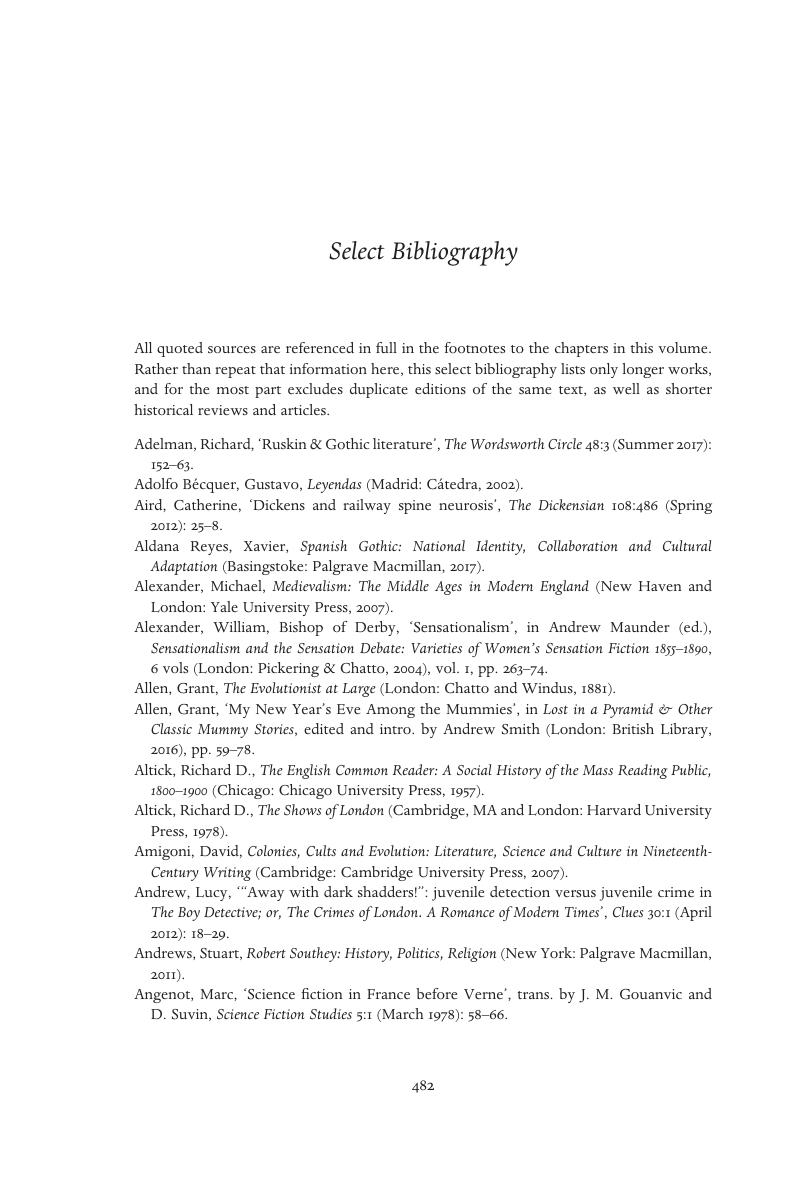Book contents
- The Cambridge History of the Gothic
- The Cambridge History of the Gothic
- The Cambridge History of the Gothic
- Copyright page
- Contents
- Illustrations and Captions for Volume II
- Tables
- Notes on Contributors
- Acknowledgements
- Introduction: Gothic in the Nineteenth Century, 1800–1900
- 2.1 Gothic Romanticism and the Summer of 1816
- 2.2 Fantasmagoriana: The Cosmopolitan Gothic and Frankenstein
- 2.3 The Mutation of the Vampire in Nineteenth-Century Gothic
- 2.4 From Romantic Gothic to Victorian Medievalism: 1817 and 1877
- 2.5 Nineteenth-Century Gothic Architectural Aesthetics: A. W. N. Pugin, John Ruskin and William Morris
- 2.6 Gothic Fiction, from Shilling Shockers to Penny Bloods
- 2.7 The Theatrical Gothic in the Nineteenth Century
- 2.8 ‘Spectrology’: Gothic Showmanship in Nineteenth-Century Popular Shows and Media
- 2.9 The Gothic in Victorian Poetry
- 2.10 The Genesis of the Victorian Ghost Story
- 2.11 Charles Dickens and the Gothic
- 2.12 Victorian Domestic Gothic Fiction
- 2.13 The Gothic in Nineteenth-Century Spain
- 2.14 The Gothic in Nineteenth-Century Italy
- 2.15 The Gothic in Nineteenth-Century Scotland
- 2.16 The Gothic in Nineteenth-Century Ireland
- 2.17 The Gothic in Nineteenth-Century America
- 2.18 Nineteenth-Century British and American Gothic and the History of Slavery
- 2.19 Genealogies of Monstrosity: Darwin, the Biology of Crime and Nineteenth-Century British Gothic Literature
- 2.20 Gothic and the Coming of the Railways
- 2.21 Gothic Imperialism at the Fin de siècle
- Select Bibliography
- Index
- References
Select Bibliography
Published online by Cambridge University Press: 18 July 2020
- The Cambridge History of the Gothic
- The Cambridge History of the Gothic
- The Cambridge History of the Gothic
- Copyright page
- Contents
- Illustrations and Captions for Volume II
- Tables
- Notes on Contributors
- Acknowledgements
- Introduction: Gothic in the Nineteenth Century, 1800–1900
- 2.1 Gothic Romanticism and the Summer of 1816
- 2.2 Fantasmagoriana: The Cosmopolitan Gothic and Frankenstein
- 2.3 The Mutation of the Vampire in Nineteenth-Century Gothic
- 2.4 From Romantic Gothic to Victorian Medievalism: 1817 and 1877
- 2.5 Nineteenth-Century Gothic Architectural Aesthetics: A. W. N. Pugin, John Ruskin and William Morris
- 2.6 Gothic Fiction, from Shilling Shockers to Penny Bloods
- 2.7 The Theatrical Gothic in the Nineteenth Century
- 2.8 ‘Spectrology’: Gothic Showmanship in Nineteenth-Century Popular Shows and Media
- 2.9 The Gothic in Victorian Poetry
- 2.10 The Genesis of the Victorian Ghost Story
- 2.11 Charles Dickens and the Gothic
- 2.12 Victorian Domestic Gothic Fiction
- 2.13 The Gothic in Nineteenth-Century Spain
- 2.14 The Gothic in Nineteenth-Century Italy
- 2.15 The Gothic in Nineteenth-Century Scotland
- 2.16 The Gothic in Nineteenth-Century Ireland
- 2.17 The Gothic in Nineteenth-Century America
- 2.18 Nineteenth-Century British and American Gothic and the History of Slavery
- 2.19 Genealogies of Monstrosity: Darwin, the Biology of Crime and Nineteenth-Century British Gothic Literature
- 2.20 Gothic and the Coming of the Railways
- 2.21 Gothic Imperialism at the Fin de siècle
- Select Bibliography
- Index
- References
Summary

- Type
- Chapter
- Information
- The Cambridge History of the Gothic , pp. 482 - 519Publisher: Cambridge University PressPrint publication year: 2020

